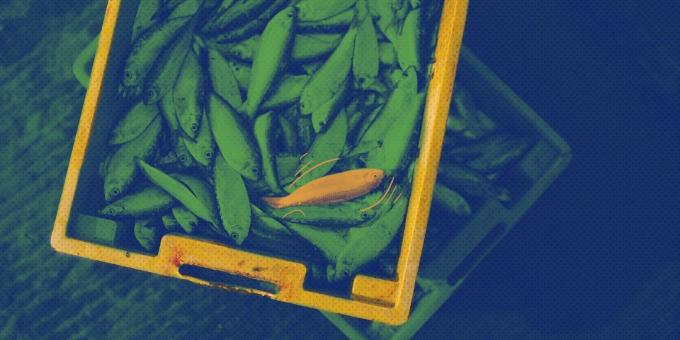How to stop buying substandard products in the supermarket
Food / / December 19, 2019
Five signs, which must be investigated, not to harm their health and do not spend money for nothing.
tempting packaging
Taking a box or jar in hand, you should immediately understand what kind of product. Marketers try to lure you with all means available to them, so be attentive to their tricks.
What to look for
Strange name. Pass by the goods which names sound strange, mysterious and contain diminutive suffixes. For example, "Varonka", "Smetanka" or "Butter" - is hardly true boiled condensed milk, cream and butter.
If the name of the product you are confused - bring it back on the shelf.
Some products we habitually call simplistically: for example, "stew" instead of "beef / pork stew." But these are two different products. "Beef / Pork stew" is getting ready for the guests, and what is called a "stew" - according to TU, or technical conditions. It is not forbidden, but in the "stew" may include soy protein, water and other ingredients that are not prescribed in the recipe according to GOST.
It is not always the name - it's a way to cheat the buyer, we can make a mistake sometimes only because of their own carelessness. For example, confuse the "cheese" and "cheese product": they look the same, but instead of cream in the second case, a vegetable fats. They are cheaper, and manufacturers use them to save on raw materials.
Big promises. "Intergalactic quality", "sugar-free" and other statements that are either known to be true, or too general. Or promises that can not be verified. For example, multifruit juice, which "contains guava juice." Formally, this is true, but if you look at the composition of this ingredient will be in last place with a note "0.2%".
Flirting with the fans of healthy lifestyles. For example, it is unnecessary inscription "no cholesterol" on the packaging of sunflower oil. After all vegetable fats cholesterol simply can not be - it is a satellite of animal fats. And the inscription "completely natural product" and "100% Organic" - a grinvoshing. More than 90% of such statements - a marketing ploy. Check the packaging, which stated "no sugar". Most likely, by this phrase manufacturer has in mind only the white sugar. Instead of it he can add sucrose, maltose, corn syrup, molasses, fructose. It is all too sugar.
Bright "child" package. The product can be psevdodetskim. For example, in the form of cooked breakfast chocolate balls: Packaging looks nice, and ads in convincing benefits for the child. In fact, such foods to children to give undesirable - it is very much sugar.
Unnatural appearance

Some manufacturers try to sell the goods at any price. To do this, it makes it incredibly beautiful. So much so that it looks unnatural.
What to look for
Too much glitter. Cast gloss may apples - they are covered with wax, so they do not spoil during transport and storage, and have longer marketable. By itself, the wax is not dangerous, but the problem is that it absorbs pesticidesWhich can be processed fruits. Apple will retain the freshness and beautiful, but with chemicals.
It is brilliant and fish fillet: It is pumped with polyphosphate solution for retaining moisture. Such a product can be repeatedly freeze and thaw, the fillet is dry and will look perfectly smooth and glossy.
Very saturated colors. Bright pink sausage and sausage doctoral - products, which have added dyes and coloring latches.
Unrealistic shelf life
The reason to question the quality of the product have become too big, and too little shelf life. They can talk about violations of technology in the production of goods or an excess preservatives.
Recall what should be a shelf life of at the most popular foods:
- milk: pasteurized stored up to 5 days Sterilized - 7 days in UHT Tetra Pak - up to 6 months;
- cottage cheese: 5 days;
- eggs: Diet did not stay fresh longer than 7 days, cutlery - from 8 to 25 days out of the refrigerator and up to 120 days in the refrigerator;
- Bread and bakery products: 3 days.
Harmful composition and warnings
On the label of any product should be given not only to complete the composition, but also about the dangers of information of a particular ingredient.
What to look for
Nutritional supplements. Familiar "eshki" can be both harmful and beneficial. For example, E300 - is vitamin C, and E306 / E309 - vitamin E. But the E122, E104, E110, E129, E124, E102 - dyes dangerous for children. If they are in the product, on the label should be a warning message "contains the coloring agent (s) that may have an adverse effect on activity and attention of children."
Allergens. It must be specified immediately after the composition. about allergens sentence begins with the words "May contain ..." or "Contains ...". For example, "product may contain traces of soybeans and peanuts."
To select only good products, watch for research Roskachestva. This independent non-profit organization conducts a detailed expert analysis of the different products. The results of these studies high quality goods is assigned to the Russian Quality Mark: capital letter "K" in the pentagon. You see it on the packaging - you know: the product not only meets all the norms and standards, but in some ways ahead of them.
The fine print and content labels
Be sure to get a grasp of the fine print on the label. This is an excellent indicator of the quality of the product.
What to look for
Location ingredients. As part of the components of the product are listed in descending order, that is, in the first place is a substance which most. For example, in white bread at the beginning of the list will be wheat flour, and in the end - salt or sugar. By this logic, in rye bread in the first place should stand rye flour. But it is not always: there is often more than wheat flour.
Region of origin. Sometimes there may be hiding a dirty trick - for example, if the sea salt produced in Moscow, where there is no sea, and the wine in Murmansk, where it is not growing grapes.
Required characters. On each of their label must be at least three:
- Single sign of products on the market states - members of the Customs Union.
- Characteristic "of non-toxic material" - the symbol "glass-fork».
- Code Letter plastic (1 to 7), which tells about the safety of the material and the degree of utilization. If the product in Europe and declared as organic on the label must be present euro-leaf - a white sheet on a green background.
Weight or volume of the product and package size. Check whether they are consistent with each other: in the usual size of the package may be only 863 milliliters of milk, while at the same price you are used to paying for a liter. Buying products stored in a liquid (e.g., olives in brine or syrup pineapple ring) does not necessarily refer to the total weight, and the weight loss of liquid: the manufacturer is obliged to specify it.
To learn which products are checked Roskachestvom



